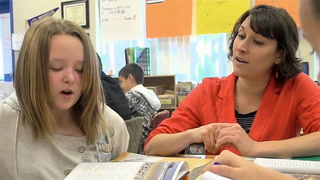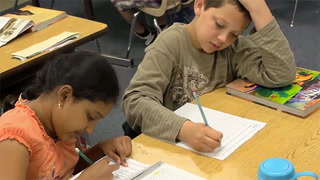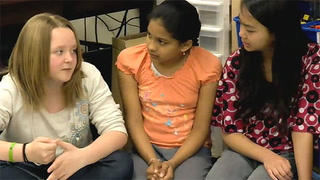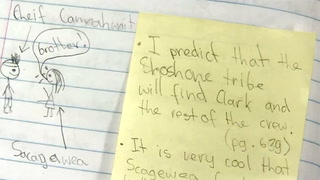Series Analyzing Texts: Analyzing Texts: Putting Thoughts on Paper
ELA.W.5.2b
| Common core State Standards
- ELA: English Language Arts
- W: Writing Standards K-5
- 5: 5th Grade
-
2b:
Write informative/explanatory texts to examine a
topic and convey ideas and information clearly.
a. Introduce a topic clearly, provide a general
observation and focus, and group related
information logically; include formatting (e.g.,
headings), illustrations, and multimedia when
useful to aiding comprehension.
b. Develop the topic with facts, definitions,
concrete details, quotations, or other
information and examples related to the topic.
c. Link ideas within and across categories of
information using words, phrases, and clauses
(e.g., in contrast, especially).
d. Use precise language and domain-specific
vocabulary to inform about or explain the
topic.
e. Provide a concluding statement or section
related to the information or explanation
presented.
ELA.W.5.9b
Common core State Standards
- ELA: English Language Arts
- W: Writing Standards K-5
- 5: 5th Grade
-
9b:
Draw evidence from literary or informational texts
to support analysis, reflection, and research.
a. Apply grade 5 Reading standards to literature
(e.g., \"Compare and contrast two or more
characters, settings, or events in a story or a
drama, drawing on specific details in the text
[e.g., how characters interact]\"\x80\x9D).
b. Apply grade 5 Reading standards to
informational texts (e.g., \"\x80\x9CExplain how
an author uses reasons and evidence to
support particular points in a text, identifying
which reasons and evidence support which
point[s]\").
Save to My Resources
PLEASE CREATE A NEW ACCOUNT OR LOG IN TO ACCESS THIS CONTENT
Enjoy your first video for free. Subscribe for unlimited access.
Have questions about subscribing?
Click Here to learn more about individual subscriptions.
Click Here to learn more about School and Institution access.
Discussion and Supporting Materials
Thought starters
- What structures does Ms. Brewer have in place to allow for effective differentiation?
- The class spent a lot of time talking before writing. What effect did this have?
- When Ms. Brewer works with the small group, how does she support English Language Learners?
School Details
Stevenson Elementary School14220 Northeast 8th Street
Bellevue WA 98007
Population: 684
Data Provided By:

Teachers
Stacy Brewer
Newest
|
4 MIN
|
5 MIN
|
5 MIN
UNCUT CLASSROOMS
| TCHERS' VOICE
English Language Arts












42 Comments
Kassandra Amaya Oct 13, 2023 1:36pm
A) She first assigned the same questions that they went over before in Tex Talk and while most of the class worked independatly, she pulled some students who need extra support from her and these students happen to be ELLs. Both groups of students are assigned the same questions and are expected to answer the questions.
B) Talking before writing allowed the students to bounce of ideas and opinions they had about the text they had read and allowed to have more information and more than just a general understanding of what they were going to write. What they talked about, the questions they answered, they will simply be repeating what they said down on the paper.
C) The teacher wanted to give students in the small group, who are all ELLs, a chance to speak more and voice their opinions. She asked questions like " How did the author feel about Lewis and Clark?" and she praises them when they use strong vocabulary words. She also makes sure that all students in the group get a chance to speak. She asks how they are start their writing and gives them each one a chance to speak.
Kim Charlson Jul 16, 2022 2:30pm
Text Talk TIme is so beneficial. I feel it supports not only students as they cite evidence after sharing their thinking, but it also instils the confidence needed to become successful and helps to foster a love of reading for meaning.
Giancarlo Esposito Dec 9, 2021 7:28am
https://youtube.com/
<a href="https://www.youtube.com/">https://www.youtube.com/</a>
[url=https://www.youtube.com/]https://www.youtube.com/[/url]
Kelsey Pratt Nov 12, 2020 12:53pm
1.) Most notably, Ms. Brewer incorporated differentiation into the lesson through working closely with a small group of English Language-Learners. This worked because the rest of the students understood the expectation that they were to write independently, and it allowed for Ms. Brewer to help develop the ELLs conception of the word ' viewpoint,' particulalry in relation to how the author of the text viewed Lewis and Clark. Once the students had established that 'viewpoint' meant 'what you think in your mind about a certain topic,' she helped them construct one sentence reflecting the main viewpoint of the author. When students shared that the author thought Lewis and Clark "didn't back down from a challenge" or "weren't afraid of anything," Ms. Brewer helped them to find concise vocabularly words in English that summed up characteristics of the historical figures, such as 'brave' or 'determined.' Since the non-ELL students did not need the small-group scaffold, they were afforded the opportunity to put their critical thoughts from 'text talk time' into writing while working on their own.
2.) I have interned with a fifth grade classroom before, and I found that it was critical for students to verbally brainstorm their ideas before putting them on paper. In the case of Ms. Brewer's classroom, the 'text talk time' allowed for the students to test the validity of their claims and supporting evidence about the author's viewpoint towards Lewis and Clark. Talking through basic opinions helps for emerging writers to solidify their ideas before they are faced with the task of composing a detailed response. Through participating in a large-group discussion, the students gained the opportunity to consider their peers' arguments and pick up pieces of textual evidence that they might include in their independent writing prompt.
3.) When Ms. Brewer works with the small group, she supports English Language Learners by first assesing their knowledge of the vocabulary necessary to answer the central question - "What is the viewpoint of the author, and how do they feel about Lewis and Clark as historical figures?" Once the ELL students demonstrated that they understood what the term 'viewpoint' meant in the context of the question, Ms. Brewer asked them to write one sentance that reflected how the author viewed/felt about Lewis and Clark. When a few of the students replied, "The author thought they they were able to overcome anything they set their minds to when they crossed the waterfall," they demonstrated that they weren't familiar with a concise English vocabularly word that could apply. To help them briefly define Lewis and Clark's characters, Ms. Brewer suggested words such as "brave" and "determined" to encourage the students to be more concise in their writing. This was an effective startegy that allowed for the ELL's to connect their excellent thoughts to the written portion of the activity.
Briana Coman Oct 5, 2020 5:29pm
This video does a good job of showing how DI is important for students to learn especially when they are in crucial need of support. This is helpful for students as the entire class is not waiting on those who need more time nor do those students left behind. Ms. Brewer is also so kind with her students and lifts them up and encourages them which is awesome to see.